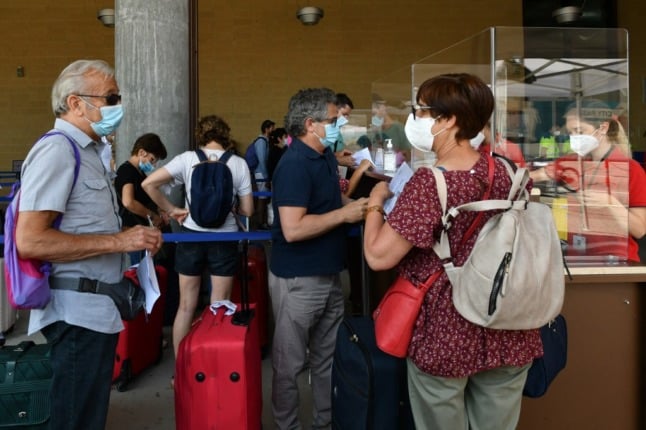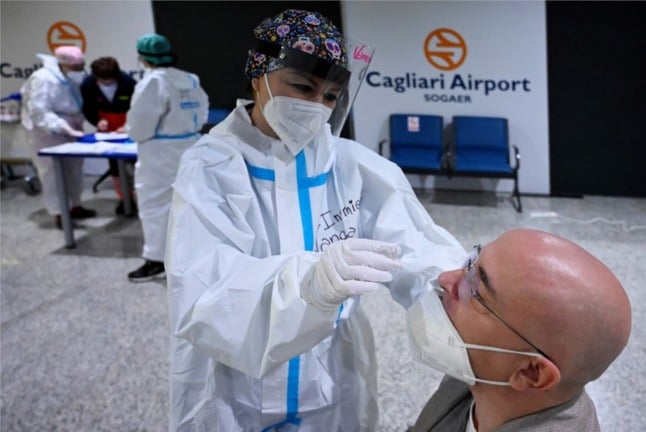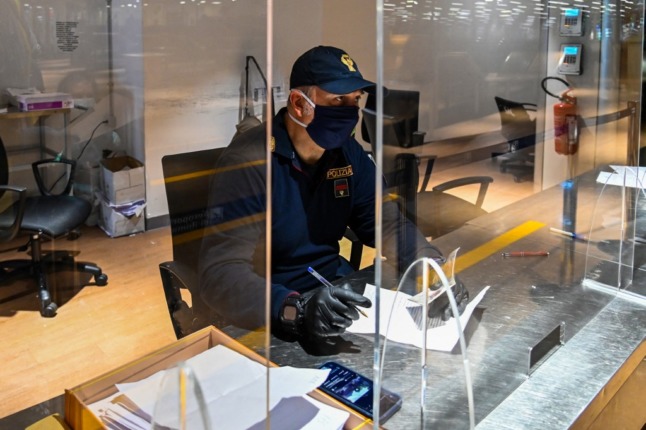The Italian health ministry toughened its rules for UK arrivals from June 21st due to concern about the rise in new coronavirus cases in Britain fuelled by the highly transmissible Delta variant.
This means Italy now requires two coronavirus tests and five days in quarantine for any travellers who have been in the UK in the past fortnight.
That includes people who have been vaccinated against Covid-19.
READ ALSO: How should travellers from the UK quarantine in Italy?
But though Italian authorities have clearly stated what the rules are (you can find a complete guide here) the way things actually work in practice can differ slightly from one part of Italy to another.
As many readers have asked about how exactly the Italian authorities are monitoring arrivals and enforcing the rules, we spoke to those who’ve travelled recently about their experiences.
What should I expect when travelling to Italy?
Several readers said they were unsure about which documents they’d be asked for when travelling, particularly due to confusion about the rules for vaccinated travellers.
At the moment, Italy is not recognising proof of vaccination issued in the UK for entry.
For travel to the country, the Italian rules state that passengers must show two documents: a negative test result from within the previous 48 hours – this can be either molecular (PCR) or a rapid antigen swab – and a completed European Digital Passenger Locator Form (dPLF), giving details of where you’re departing from and where you’ll be staying. The form is available online here.
These rules seem to be being applied consistently, according to those we spoke to.
“After feeling very stressed about the required private Covid test and uploading it to my boarding pass along with the EU Passenger Locator Form before departure, it all worked very easily,” said Julia in Calabria, who flew from Stansted.
“My Covid test was looked at every step of the way – it’s a good idea to print it off as well as having it on your phone. On entering Italy they checked the Covid test and the print-off of the EU-plf, and asked me to self-isolate for five days.”
Reader question: How likely is Italy to change its restrictions on travel from the UK?

Linda in Tuscany said: “I was worried that I wasn’t going to be allowed to leave the UK until the plane actually took off. I had been really careful to gather all the documentation required but still wasn’t sure I had it all.
“When leaving the UK I was asked for my passport, passenger locator form and my Covid test certificate. When I got into Pisa I was asked for the same things. I had also collected my vaccination certificate (Scotland), proof of where I was staying, permission from the property owner, evidence of travel insurance and all my car hire documentation including extra insurance and none of that was asked for.”
All those who drove from the UK meanwhile said they had their documents checked when crossing the French border but not when entering Italy.
As the France-Italy border is within the EU and Schengen zone, fewer checks may be carried out – but the same rules still apply regardless of whether you enter Italy by plane, ferry, train, coach, private car or any other means of transport.
How do I report to the local authority and organise testing?
Once you’re in Italy, the rules say you should contact your local health authority to report your presence within 48 hours of arrival.
Depending on where you’re going, this may involve filling out an online form, sending an email or calling a regional helpline. Find contact details here.
Several readers in the region of Tuscany told us that, despite some initial confusion when calling the regional helpline, doctors from the local health authority not only called them back, but also arranged for them to be tested at the end of the quarantine period.
“I phoned the Sistema Informativo Sanitario della Prevenzione Collettiva (SISPC) to announce my arrival and to start quarantine. I was 47th in the queue! However it didn’t take long to get to speak to someone,” said Linda.
“They sent me an email repeating the information I had given them and also telling me what to do if I had Covid symptoms.
“The following day, a doctor phoned and asked if I had symptoms, and reminded me to quarantine.”
Linda added that when a friend attempted to make an appointment for her to be tested at a local pharmacy, “she found out I already had an appointment, so the doctor must’ve made me one.”
“I was quite impressed with their efficiency and how careful they are being.”
Not all regions do this, however. Whether you can organise your own test via a private provider such as a pharmacy or need to go through the public health service depends on the rules in your region.
If in doubt, ask your local health authority or the regional Covid helpline for advice.

In the region of Emilia Romagna, reader Carlo said his test was also arranged for him, and he was able to complete an online form instead of phoning.
“During my quarantine period I was contacted by phone and email by the health authority informing me of the quarantine requirements, part of this was how I would take a quarantine release test.
“They organised this test, which needed to be a molecular test, at a local hospital for me to take on day six.”
Several readers in different regions noted that their local health authority insisted on a molecular (PCR) test, even though Italy’s national rules (and therefore the Italian travel rules published on the UK government website) state that either a PCR or antigen test will be accepted at the end of the quarantine period.
Differences such as this exist because each of Italy’s 21 regional authorities are free to set stricter rules of their own, on top of the national measures.
Will the helpline staff speak English?
Though some regional helplines say they’re available in English and other languages, in practice it appears likely that you’ll need to speak to someone in Italian, at least initially.
If you’re worried that your Italian language skills aren’t up to the task, you are allowed to have someone else (such as an Italian friend or relative) phone on your behalf, though they will need to be able to provide your personal details.
In Sicily, reader Peter in the province of Messina reported that he was able to get by despite not yet having mastered the language.
“The Sicilian Covid helpline is Italian language only, and you are met with a long recorded message – still not sure what was being said! However, a few minutes after calling, I got a return call and read in Italian (from my scripted research) that I was calling to report my wife’s re-entry to Sicily and that I couldn’t speak enough Italian to hold a conversation,” he said.
READ ALSO: The essential Italian phrases you need to know for getting tested and vaccinated
“God bless her, the young lady on the other end of the line spoke in pretty poor English, but much better than my Italian and we got there, although the process seemed to simply regurgitate the information on the PLF form.”
He later received a call from the local hospital – this time from a fluent English speaker – who organised a PCR test for the day following the end of quarantine.
“The reporting in and test arrangements have been undertaken efficiently, professionally and with a great deal of courtesy,” Peter said.
Will anyone check up on me?
Local health authorities have the right to call or even visit you in person to check that you’re observing quarantine.
Many of the people The Local spoke to said they’d received some kind of follow-up from their area’s local health authority during their quarantine period, while others said they hadn’t heard anything.
But, as penalties for failing to follow the quarantine rules can be stiff, including fines of up to a thousand euros, it’s best to assume the rules will be enforced and act accordingly.
Find more details of the Italian quarantine rules here.
If you need to book a coronavirus test in Italy, find a complete guide to doing so here.
For more information about the requirements for travelling between the UK and Italy see the Italian Health Ministry’s website, or consult the Italian Embassy in London or British Embassy in Rome.
Thank you to everyone who took the time to share their travel experiences with us, including those whose comments we weren’t able to include in this article.



 Please whitelist us to continue reading.
Please whitelist us to continue reading.
Hi, do you know if during quarantine, you can get your dog out to exercise? For us is OK being indoors, but my problem is the dog…
My sisters who travelled from England to stay with us in Emilia Romagna were provided with an email setting out quarantine guidance after they had notified the health authority. This should give you the information you need. We didn’t notice anything about dogs but it was only provided in Italian and we only really read what applied to our situation. I do know that we (we self isolated with my sisters to avoid complications) were not even allowed to take rubbish out during the five days so it is quite restricted. Do you have a friend, family member or neighbour who could walk the dog for you?
As stated above if driving the only control you will come across is the French at the Euro tunnel who do not even want to let you through unless vaccinated. In Italy, nobody knew i had been in the UK as i did not inform anyone.